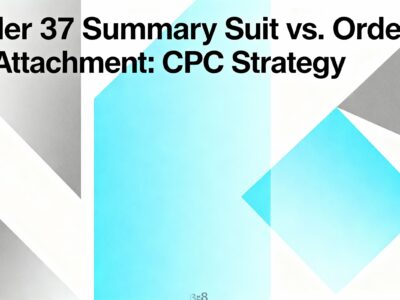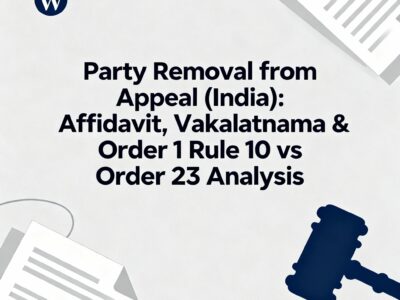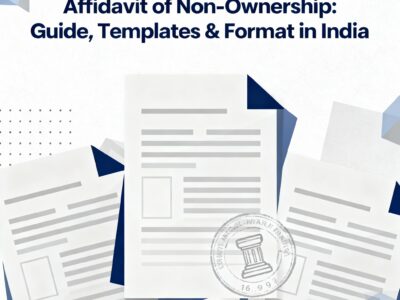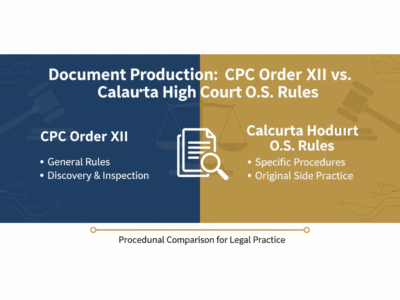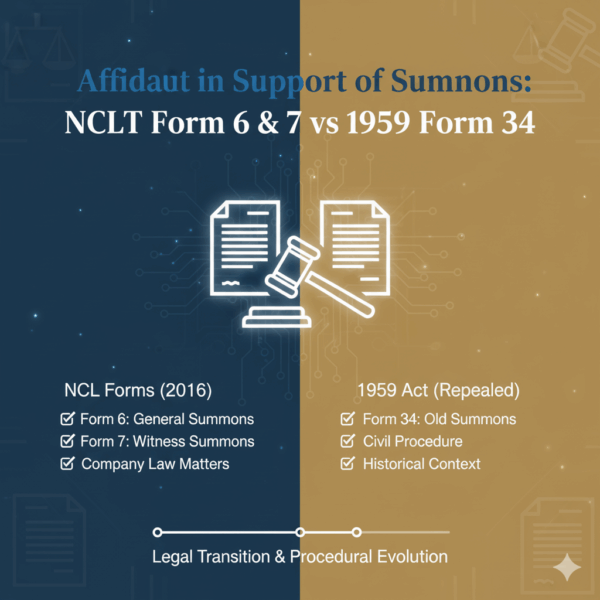When a subordinate court passes a non-appealable order, a party may seek correction from the High Court through a Civil Revision Petition (CRP) under Section 115 of the Code of Civil Procedure, 1908.
Filing the CRP is only the first step. The petitioner almost always needs to file a separate application for a stay to prevent the lower court’s proceedings from continuing. The affidavit supporting this stay application is not a simple formality; it is the central piece of evidence that can determine the petition’s success at the admission stage.
This guide explains the function of this affidavit, its necessary components, and how its contents connect directly to the legal tests for jurisdictional error, a prima facie case, and irreparable injury.
Affidavit in a Civil Revision Petition and Application for Stay under Section 115 of the CPC
A detailed guide on the affidavit's role, procedural requirements, and strategic importance in High Court revisions.
When a subordinate court passes a non-appealable order, a party may seek correction from the High Court through a Civil Revision Petition (CRP) under Section 115 of the Code of Civil Procedure, 1908. Filing the CRP is only the first step. The petitioner almost always needs to file a separate application for a stay to prevent the lower court's proceedings from continuing. The affidavit supporting this stay application is not a simple formality; it is the central piece of evidence that can determine the petition's success at the admission stage.
This guide explains the function of this affidavit, its necessary components, and how its contents connect directly to the legal tests under Section 115.
What is a Civil Revision Petition (CRP)?
A CRP is not an appeal. An appeal allows a higher court to re-examine facts and law. A revision under Section 115 is a request for the High Court to exercise its supervisory power. The High Court's purpose is to check if a subordinate court has made a "jurisdictional error."
Basic Flow for Filing a CRP
The Three Types of Jurisdictional Error
To succeed, the petitioner must show the subordinate court committed one of the three errors listed in Section 115(1).
| Ground | Section 115(1)(a) | Section 115(1)(b) | Section 115(1)(c) |
|---|---|---|---|
| What it Means | The court exercised a jurisdiction it did not possess. | The court refused to exercise a jurisdiction it did possess. | The court acted illegally or with material irregularity in exercising its jurisdiction. |
| Simple Example | A court with a financial limit of ₹10 Lakhs decides a case worth ₹20 Lakhs. | A court wrongly dismisses a valid application, believing it has no authority to hear it. | The court decides a case without giving a party a chance to be heard, violating natural justice. |
The Proviso: The Main Hurdle for Admission
Even if a jurisdictional error exists, the 1999 amendment to the CPC added a proviso. The High Court *will not* interfere with an order *unless* one of two conditions is met:
- The order, if ruled in the petitioner's favor, would have **finally disposed** of the suit; OR
- The order, if allowed to stand, will cause a **failure of justice** or **irreparable injury** to the petitioner.
This second point, "irreparable injury," is where the affidavit becomes essential. The affidavit must provide the *facts* that prove this injury.
Why CRPs Fail at the Admission Stage
Many petitions are dismissed because they fail to satisfy the proviso. The affidavit is the first and best chance to present this evidence.
The Affidavit's Job: The Three-Prong Test
Filing a CRP does not automatically stop the lower court's case (per Section 115(3)). A separate stay application is needed. To get a stay, the affidavit must provide facts that satisfy three legal tests:
1. Prima Facie Case
The affidavit must show that the CRP has a good, arguable case. It suggests the petition is likely to succeed. The "incorporation by reference" clause (see below) helps by making all grounds in the CRP part of the affidavit.
2. Irreparable Injury
This is the most important part. The affidavit must state *facts* showing harm that cannot be fixed with money. For example, being forced to participate in a long, expensive, and non-maintainable proceeding is an injury in itself.
3. Balance of Convenience
The affidavit must show that the harm to the petitioner (if no stay is granted) is far greater than the inconvenience to the respondent (if the stay is granted). It argues that justice favors pausing the case.
Drafting the Affidavit: A Filterable Checklist
A well-drafted affidavit contains specific components. Use the filters below to see which parts are mandatory and which are strategic drafting tips.
- [Mandatory] Caption: Correctly state the court, petition numbers, and party names.
- [Mandatory] Deponent's Introduction: State your name, age, address, and your relationship to the case (e.g., "I am the petitioner...").
- [Mandatory] Statement of Competence: A line stating you are "well acquainted with the facts of the case and competent to swear this affidavit."
- [Mandatory] Factual Matrix: Briefly state the facts. What order was passed? On what date? Why is it being challenged?
- [Drafting Tip] Incorporation by Reference: Include a paragraph stating, "For the sake of brevity, the contents of the Memorandum of Civil Revision Petition may be read as part of this affidavit." This legally pulls all your legal grounds into the sworn statement.
- [Drafting Tip] Specific Injury Clause: Do not just say "I will suffer irreparable injury." *Show* it. Example: "If the stay is not granted, the petitioner will be forced to contest the appeal on merits, which is non-maintainable, causing a multiplicity of proceedings and wasting judicial time."
- [Mandatory] Verification: This is the final, sworn statement that the contents are true. It must be signed by the deponent and attested by an Oaths Commissioner or Notary.
- [Drafting Tip] Bifurcated Verification: A common mistake is a simple verification. A proper one (as per Order 19, Rule 3) separates facts: "I verify that paras 1-4 are true to my personal knowledge, and para 5 is based on legal advice received, which I believe to be true."
Common Mistakes to Avoid
A weak affidavit can lead to the stay application being dismissed, allowing the lower court to proceed and possibly making your CRP infructuous.
| Common Mistake | Why It Fails | Better Practice |
|---|---|---|
| Vague "Irreparable Injury" Plea | Using boilerplate language like "the petitioner will suffer irreparable loss" is a legal conclusion, not a fact. The court needs evidence. | Be specific. State *what* the injury is. (e.t., "Forcing the petitioner to defend a time-barred suit..."). |
| Improper Verification | A verification that does not distinguish between personal knowledge and information/belief is technically defective and can be rejected. | Use a bifurcated verification that clearly separates the sources of your statements, as required by procedural law. |
| Assuming a Stay is Automatic | Some litigants file a CRP and do nothing, believing the lower court case stops. It does not. | Always file a separate application for stay (C.M.P. or I.A.) with a strong supporting affidavit and actively press for an interim order. |
Sample Affidavit Template (from Document)
This is a foundational template based on the provided document. It must be adapted by a legal professional to fit the exact facts and circumstances of your case.
BEFORE THE HON'BLE ___________ COURT AT _______
CIVIL MISCELLANEOUS PETITION NO.____ OF 20__
IN CIVIL REVISION PETITION NO____ OF ____
Mr. _______________________________
PETITIONER
VERSUS
MR. ________________________________
RESPONDENT
AFFIDAVIT
I, ____________________________, Wife of _____________, Daughter of ______ __________________________ , aged______ years, resident of _______________ , do hereby solemnly affirm and state as follows:
1. That I am the petitioner in the Civil Miscellaneous Petition and the Civil Revision Petition referred to above. The deponent herein is well acquainted with the facts and circumstances of the case and being competent to swear this affidavit.
2. That the contents of the Civil Revision Petition and the application for stay may be read as part of this affidavit for the sake of brevity.
3. That the petitioner has a prima facie case in his favour and is likely to succeed in the Civil Revision Petition.
4. That the balance of convenience lies in favour of the petitioner.
5. That if the stay as prayed for is not granted, the petitioner will suffer irreparable loss and injury which cannot be compensated in terms of money.
6. That the petition is made bona fide and in the interest of justice.
7. That the facts stated above are true and correct to the best of my knowledge, belief and information and nothing material has been concealed therefrom.
DEPONENT
Full Text: Section 115, CPC (Revision)
This is the complete text of Section 115 of the Code of Civil Procedure, 1908, as provided in the research document. Understanding this statute is essential for drafting the petition and the affidavit.
"Revision"
(1) The High Court may call for the record of any case which has been decided by any Court subordinate to such High Court and in which no appeal lies thereto, and if such subordinate Court appears-
(a) to have exercised a jurisdiction not vested in it by law, or
(b) to have failed to exercise a jurisdiction so vested, or
(c) to have acted in the exercise of its jurisdiction illegally or with material irregularity,
the High Court may make such order in the case as it thinks fit:
Provided that the High Court shall not, under this section, vary or reverse any order made, or any order deciding an issue, in the course of a suit or other proceeding, except where-
(a) the order, if it had been made in favour of the party applying for revision, would have finally disposed of the suit or other proceedings, or
(b) the order, if allowed to stand, would occasion a failure of justice or cause irreparable injury to the party against whom it was made.
(2) The High Court shall not, under this section, vary or reverse any decree or order against which an appeal lies either to the High Court or to any Court subordinate thereto.
Explanation.-In this section, the expression "any case which has been decided" includes any order made, or any order deciding an issue in the course of a suit or other proceeding.
Key Judicial Pronouncements on Section 115
The scope of Section 115 has been interpreted and refined by the Supreme Court and various High Courts over decades. Understanding these judgments is key to framing the grounds of a revision petition.
| Case Law | Principle Established/Clarified | Relevance to Your Affidavit |
|---|---|---|
| Manish Mohan Sharma vs. Ram Bahadur Thakur Ltd. (2006) | Clarified the meaning of "irreparable injury" and "failure of justice" under the proviso. The court held that the injury must be one that cannot be adequately compensated by costs or remedied at a later stage. | Your affidavit must state facts that meet this high standard. Show *how* the injury cannot be fixed later, even if you win the final suit. |
| Keshardeo Chamria vs. Radha Kissen Chamria (1953) | This case helped define "any case which has been decided." It established that an order can be revisable even if it doesn't dispose of the entire suit, as long as it decides a specific matter or issue between the parties. | This supports challenging interlocutory orders. The affidavit should specify the *issue* that the lower court wrongly decided, linking it to a ground in the petition. |
| Hindustan Aeronautics Ltd. vs. Fatta (2002) | Reinforced that the revisional jurisdiction is not for correcting minor errors of fact or law. It is only for cases where the subordinate court has acted without jurisdiction or with material irregularity causing prejudice. | This reminds you that the affidavit should focus on *jurisdictional* errors, not just why you disagree with the order on merits. |
Distinguishing Roles: The Petition vs. The Affidavit
A common mistake is to confuse the purpose of the main petition with the purpose of the supporting affidavit. They have two distinct and complementary legal roles.
The Civil Revision Petition (The "What")
Legal Role: Pleadings
This document contains the *legal arguments*. It is a formal request to the High Court, outlining:
- The facts of the case (briefly).
- The specific order being challenged.
- The "Grounds for Revision" – these are the legal points arguing *what* jurisdictional error the lower court made (e.g., "The Ld. Judge erred in law...").
This document *argues* the law.
The Affidavit (The "Why")
Legal Role: Evidence
This document contains the *sworn facts* that support your application for a stay. It is your testimony, stating:
- That you are the petitioner and know the facts.
- The *factual* basis for the three-prong test (Prima Facie Case, Irreparable Injury, Balance of Convenience).
- *Why* you will suffer a failure of justice if the stay is not granted.
This document *proves* the facts.
Frequently Asked Questions (FAQ)
Here are answers to common questions regarding Civil Revision Petitions and stay applications.
A: An **Appeal** (like under Section 96 of the CPC) is a broad right to have a higher court re-examine both facts and law. You can essentially re-argue your case. A **Revision** (Section 115) is extremely narrow. It is *not* an appeal. Its only purpose is to allow the High Court to correct "jurisdictional errors." You cannot argue that the lower court's decision was wrong on facts, only that it had no authority to make the decision, failed to use its authority, or acted with material irregularity.
A: **No.** This is a critical point. Filing a Civil Revision Petition does *not* automatically stay the proceedings in the subordinate court. The lower court case will continue *unless* you file a separate application for stay (often called a C.M.P. or I.A.) and the High Court passes a specific order granting an interim stay. This is why the affidavit supporting the stay application is so important.
A: "Irreparable injury" is harm that cannot be undone or compensated with money. Simply losing the case is not irreparable injury. A good example is being forced to participate in a long, expensive, and complex trial that is fundamentally non-maintainable (e.g., the case is barred by limitation). The injury here is the "multiplicity of proceedings" and the waste of time and resources, which cannot be compensated later. Your affidavit must state *facts* (not just the words) that show this specific kind of harm.
A: **No.** The proviso to Section 115 acts as a major filter. The High Court *cannot* interfere with an order *unless* that order, if made in your favor, would have **finally disposed of the suit** (e.g., an order rejecting your plea that the suit is barred by limitation), OR the order, if allowed to stand, will cause a **failure of justice or irreparable injury**. You cannot file a CRP for every minor procedural order you disagree with.
Conclusion: The Affidavit as Your Linchpin
The Civil Revision Petition under Section 115 is a limited but powerful tool for correcting jurisdictional errors. However, its power is often unlocked by the application for a stay, and that application is built entirely on the foundation of its supporting affidavit.
Do not treat the affidavit as a mere procedural formality. It is your primary (and often only) piece of evidence at the admission stage. It is your opportunity to present sworn facts that demonstrate a prima facie case, a favorable balance of convenience, and, most importantly, the "irreparable injury" or "failure of justice" required by the proviso. A well-drafted affidavit that speaks to these points directly is the linchpin that holds your entire petition together and prevents it from becoming infructuous.
Given the technical nature of revisional jurisdiction and the rules of drafting, it is essential to engage a qualified legal professional to draft and file any Civil Revision Petition and its supporting applications.


